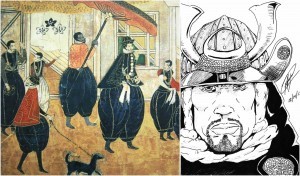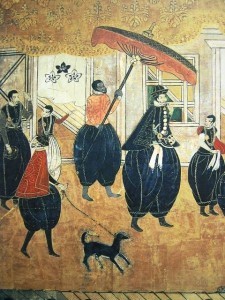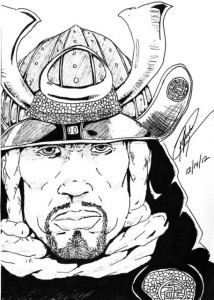According to Histoire Ecclesiastique Des Isles Et Royaumes Du Japon, written by François Solier of the Society of Jesus in 1627, Yasuke was a Muslim from Mozambique. Solier’s account may however have been an assumption, as it was written so long after the event and there is no surviving contemporary account that corroborates it. Therefore, although there is no evidence, it is also possible that he also came from Portugal, Angola or Ethiopia, and he could conceivably originally have been an African mercenary in the employ of an Indian sovereign, of which there were many at this time.
A 2013 investigation by the light entertainment television program Discovery of the World’s Mysteries suggested that Yasuke was a Makua named Yasufe. However, this was a highly journalistic investigation; the program provided little proof for their conclusions. He may otherwise have been a member of the Yao people, who were just coming in to contact with the Portuguese at this time, which might account for his name, ‘Yao’ added to the common Japanese male name suffix of ‘suke.’
Yasuke arrived in Japan in 1579 as the servant of the Italian Jesuit Alessandro Valignano, who had been appointed the Visitor (inspector) of the Jesuit missions in the Indies (meaning East Africa, Southand East Asia). He accompanied Valignano when the latter came to the capital area in March 1581 and caused something of a sensation. In one event, several people were crushed to death while clamoring to get a look at him The Jesuits feared their church would be flattened in the stampede, but they managed to avert disaster. The warlord Nobunaga, famous for his attempts to unify Japan, heard the noise from the temple where he was staying and expressed a desire to see him. Suspecting the dark color of his skin to be black ink, Nobunaga had him strip from the waist up and made him scrub his skin. These events are recorded in a 1581 letter of the Jesuit Luis Frois to Lorenço Mexia, and in the 1582 Annual Report of the Jesuit Mission in Japan, also by Frois. These were published in ‘Cartas que os padres e irmãos da Companhia de Jesus escreverão dos reynos de Japão e China II’, normally known simply as ‘Cartas,’ in 1598. Satisfied that he was, in fact, black, Nobunaga seems to have taken a shine to him. At some point following this, although when is not clear, he was either given (Japanese accounts indicate him presented to Nobunaga, although European accounts do not mention this) or allowed to enter Nobunaga’s service.
The “Lord Nobunaga Chronicle” corroborates Frois’ account, and describes their meeting thus: “On the 23rd of the 2nd month [March 23, 1581], a black page came from the Christian countries. The man was healthy and good-looking with a good demeanor. Moreover, Nobunaga praised Yasuke’s strength, describing it as that of ten normal men. Nobunaga’s nephew, probably Tsuda Nobusumi, gave him a sum of money at this first meeting.
In May, Yasuke went with Nobunaga to his castle at Azuchi and popular rumors said he might be ennobled. The diarist, Matsudaira Ietada, described him as six shaku 2 sun (6 ft. 2 in., or 188 cm.). His tall stature would have been very imposing to the Japanese of the time, even to a tall man like Nobunaga. Matsudaira stated that he was named Yasuke.
It is likely that Yasuke could speak considerable Japanese, perhaps due to Valignano’s efforts to ensure his missionaries adapted to the local culture better, because Nobunaga enjoyed talking with him (there is no indication that Nobunaga spoke Portuguese, and it is unlikely that Yasuke would have been able to communicate in classical Chinese, the oriental lingua franca of the time). He seems to have become a close retainer, perhaps the only non-Japanese ‘warrior’ that Nobunaga had in his retinue, which could account for his rapid rise in favor and status. Yasuke was also mentioned in the prototype of Shinchōkōki owned by Sonkeikaku Bunko (尊経閣文庫), the archives of theMaeda Clan. According to this, Yasuke was given his own residence and a short, ceremonial katana by Nobunaga. Nobunaga also assigned him the duty of weapon bearer.
In June 1582, Nobunaga was attacked and forced to seppuku in Honnō-ji in Kyoto by the army of Akechi Mitsuhide. Yasuke was also there at the time and fought the Akechi forces. Immediately after Nobunaga’s death, Yasuke went to the join Nobunaga’s heir Oda Nobutada who was trying to rally the Oda forces at Nijō Castle. Yasuke fought alongside the Nobutada’s forces for a long time, but he eventually surrendered his sword to Akechi’s men. They asked Akechi himself what to do with him. Akechi said that the black man was a beast and did not know anything, and furthermore, he was not Japanese, so they should not kill him but take him to the nanban-dera or nanban-ji (南蛮寺, literally the temple of the southern barbarians, how the Japanese referred to the Jesuit church). It is said that the reason why Akechi spoke it such a manner was a form of pity, i.e. giving a clear reason why not to kill him. Black people were not in fact discriminated against in Japan at this time, in fact, they were even admired, for the Buddha was often portrayed in black in Japanese temples. However, perhaps Akechi also did not want to offend the Jesuits, needing all the friends he could get at this time of political turmoil. This was much to the relief of the Jesuits there who calmed him down and thanked God for his deliverance. There is no further written information about him after this although Frois, in his ‘History of Japan, does mention a black African gunner in the service of Arima Harunobu in 1584, shortly after Yasuke’s time with Nobunaga. This is highly likely to be a different man, however, and there were many Africans in the service of Japanese and European employers, as well as independently employed men, in Japan at this time.
Ask me anything
Explore related questions







